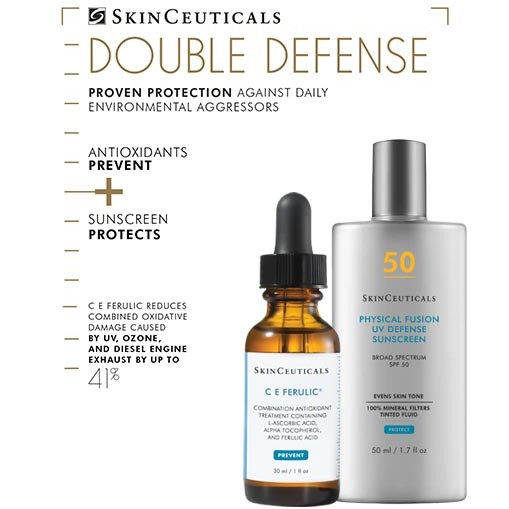Great skincare doesn’t mean the same thing for any two people. Different skin types, chronic skin conditions, even the area where you live all play into the ideal skincare routine. Age is another important factor to keep in mind when creating your daily skincare routine. According to Dr. Diana Rivers of U.S. Dermatology Partners in Centreville, Virginia, “Your skincare needs will change drastically throughout your life. By learning your skin’s needs at every age, you can more effectively care for your skin.” Keep reading to learn more about Dr. Rivers’ top tips for women’s skincare at every age.
Skincare in Your 20s
In your 20s, your skin is probably relatively healthy and youthful. You’re still producing plenty of collagen and elastin to keep your skin looking and feeling its best. However, in your 20s, you’ll begin to produce a diminishing amount of collagen. According to Dr. Rivers, “Collagen production slows about 1% each year beginning in the 20s. Additionally, cell turnover slows. This combination means many people begin to see their first wrinkles and fine lines as well as developing concerns like uneven skin tone and texture.”
Common skin health concerns for women in their 20s include:
- Acne – While teen acne may begin to clear up in the 20s, many young adults still struggle with acne. For women who begin their families at this stage, pregnancy-related hormonal changes can also trigger acne breakouts. Slower skin cell turnover may also cause pores to become clogged more readily.
- Patchy skin – Slowing skin cell turnover can also lead to patches of dry skin, flaky areas, redness, and other issues with the texture and tone of the skin.
- Fine lines and wrinkles – The first fine lines and wrinkles may appear for women in their 20s as collagen and elastin production begin to slow.
- Stretch marks – A stretch mark can develop anywhere on the body at any age. However, they are very common among pregnant women. For those who are starting their families in their 20s, preventing and addressing stretch marks may be an essential aspect of their skincare routines.
To care for skin in your 20s, keep the following in mind:
- Sunscreen – You should be applying sunscreen every day. This prevents the short-term effects of sun exposure (sunburns), but it also helps to stave off the long-term effects like sun spots, fine lines, wrinkles, and skin cancers.
- Moisturize – As your skin cells begin to turn over more slowly, you’ll likely see some dry spots. Moisturizers keep your skin hydrated and youthful. It also helps to prevent flare-ups in chronic skin conditions like eczema, acne, and psoriasis.
- Use products with acids – Look for skincare products that contain lactic, glycolic, or salicylic acids. These products promote faster cell turnover and can help to reduce the appearance of fine lines and wrinkles.
- Use antioxidants – Products that contain antioxidants can help to slow the development of wrinkles as well as preventing damage from the sun, pollutants, and other environmental irritants.
Skincare in Your 30s
For people who did great work caring for skin in their 20s, the skin will start to show the positive effects of thorough care. If you haven’t been taking great care of your skin yet, you can still create an effective skincare routine in your 30s. For women in their 30s, skincare should be focused on slowing signs of aging and keeping skin looking and feeling youthful.
Common skin health concerns for women in their 30s include:
- Decreased collagen and elastin production – While production of collagen and elastin begins to slow in the 20s, this diminishment in production continues into the 30s. Women may begin to see skin that looks loose, saggy, wrinkled, or deflated. Thinner areas, like the neck and decolletage, are often the most noticeably impacted.
- Slower skin cell turnover – a complete turnover of skin cells happens every 10 to 20 days for children through adults in their 20s. In the 30s, this process can take a full month. This leaves skin looking dull, skin tone uneven, and can cause thick patches of dry skin sometimes called scales.
- Pregnancy and skin health – For women who begin families in their 30s, pregnancy may impact the skin in a variety of ways. Stretch marks, as mentioned in the prior section, are one obvious concern. Another issue is the fluctuation in hormone production that changes how much oil the skin produces. Hormonal fluctuations can also cause changes in pigmentation (coloring) and lead to flare-ups in chronic skin conditions.
- Hyperpigmentation – Darker patches on the skin, sometimes called melasma, are another concern that may arise for women in their 30s. This often happens due to the long-term effects of exposure to the sun’s UVA and UVB rays. Expectant mothers may also develop dark spots, but these typically diminish after giving birth.
To care for skin in your 30s, keep the following in mind:
Continue your routine outlined for women in their 20s. In your 30s, it’s also time to start introducing some anti-aging products. You’ll want to continue to address the slowing cell turnover with products that will exfoliate the skin and promote the production of new skin cells. Look for serums and products that contain active ingredients like:
- Vitamin C (L-ascorbic acid)
- Vitamin A (Retinol)
- Vitamin C & E (Ferulic acid)
- Polyhydroxy, Alpha Hydroxy, and Beta Hydroxy Acid
- Salicylic Acid
- Hyaluronic Acid
Skincare in Your 40s
In their 40s, women will see the positive impact of a great skincare routine in their 20s and 30s, but even the most effective skincare can’t completely halt the changes in skin health that occur with age. In their 40s, women will begin to see the effects of lifelong sun exposure and bodily changes that come with age. Your skincare routine should be focused on correcting sun damage, minimizing the development of fine lines and wrinkles, and continuing to preserve and promote skin health.
Common skin health concerns for women in their 40s include:
- Previous concerns continue – Slower skin cell turnover and diminishment in collagen and elastin production continue.
- Lymphatic system changes – The lymphatic system removes toxins from the body. As we grow older, this system slows, which means that toxins are removed from the body more slowly. This can lead to a buildup in toxins that cause inflammation and puffiness. This is often first noticeable around the eyes.
- Slower oil production – The body begins to produce less sebum (the oil that moisturizes skin). This leads to increased dryness, and it can further emphasize the appearance of developing fine lines and wrinkles.
- Decreased estrogen levels – In perimenopause, the body produces less estrogen. This causes the skin to become dryer, thinner, and more brittle.
To care for skin in your 40s, keep the following in mind:
Continue your skincare routine from your 20s and 30s. If you haven’t already added in anti-aging products and vitamin C, this becomes even more important in the 40s. As estrogen production decreases, skin becomes thinner, which can make it more difficult for the body to retain moisture. Keeping the body moisturized from the outside remains essential, and it also becomes increasingly important to drink plenty of water to stay hydrated from the inside out.
Skincare in Your 50s
As women enter their 50s, the signs of aging are going to become more obvious. Fine lines, wrinkles, sagging, dryness, thinning, changes in pigmentation. All of these negative effects of time will begin to be more prominent. In the 50s, your skincare routine should be geared toward maintaining skin health and slowing further signs of aging.
Common skin health concerns for women in their 50s include:
- Previous skin concerns continue – Slower cell turnover, diminished collagen and elastin production, changes in oil production, hormonal fluctuations (perimenopausal skin issues), and other skin health concerns continue.
- Easy to damage skin – Diminished estrogen production and less hyaluronic acid in the second layer of skin (dermis) lead to thinner skin, which means bruising, bleeding, and inflammation occur more readily.
- Inflammation – We experience more inflammation throughout the body as we age. This increase in inflammation leads to conditions like arthritis, and it can also negatively affect the skin. Increased skin inflammation puts individuals at greater risk for damage from sun, chemical, pollutant, allergen, or irritant exposure.
To care for skin in your 50s, keep the following in mind:
You should continue all of your previous skincare steps. In addition, you should take extra care of your body and work to reduce inflammation. This may include things like limiting consumption of alcohol and caffeine, reducing time spent in the sun, and using fewer products that can irritate the skin. Choose calming and soothing skincare products that contain ingredients like oats and chamomile. Improving circulation is also important in the 50s. Decreased blood flow means necessary nutrients aren’t delivered to the cells, which can leave skin looking and feeling unhealthy. Getting plenty of exercise and massaging the skin can dramatically improve circulation.
Skincare in Your 60s & Beyond
By your 60s, it will become increasingly more difficult to improve the appearance of skin as it continues to show signs of age. While it’s hard to undo the changes that are written on your skin after so many years, you can keep taking steps to prevent additional damage and slow the signs of aging. The goal for your 60s and beyond should be to maintain whole-body health and skin health. Dr. Rivers says, “Remember, good overall health means good skin health, so take good care of yourself. Your skin will look as good as you feel.”
Common skin health concerns for women in their 60s and beyond include:
- Post-menopausal dry skin – After menopause, the skin becomes increasingly drier, so it’s important to invest in a good moisturizer and make sure you’re staying hydrated from the inside out.
- Previous concerns continue – Decreased collagen and elastin production and slower cell turnover continue into the 60s and beyond. Changes in circulation and pigmentation also continue.
- Skin growths – Skin tags, papules, benign cysts, and other growths may begin to appear in larger numbers across the skin. Any new growths should be examined by a dermatologist.
- Thinning skin – As we age, the skin becomes thinner and more sensitive. It may be more difficult for our skin to heal following injury, and we may experience greater levels of skin irritation.
To care for skin in your 60s and beyond, keep the following in mind:
You should continue all the previous skincare steps. Additionally, you should be taking steps to thicken your skin. Products that contain copper peptides are an effective option to improve skin thickness. You can often find copper peptides as active ingredients in vitamin C serums.
Visit Your Trusted Dermatologist
At any age, your skin’s best defense is a good offense, and a trusted dermatologist should be your top resource. At U.S. Dermatology Partners, we offer comprehensive dermatologic services for people of all ages. Whether you’re dealing with a chronic skin condition or you just want to turn back the hands of time, our team can help. When you’re ready to find out more about your skin health or develop the ideal skincare routine, complete our simple online scheduling request form to set up a visit with a trusted U.S. Dermatology Partners clinician near you.
Find a location near me
or



